Here is where it all started, the first stone of passion, the cradle of motorsport. The first of the historical tracks that made Formula 1 famous. A mixture of history, passion, culture, courage. The English version of races. Silverstone recalls brave times and massive enterprises – it is the right place where to begin.
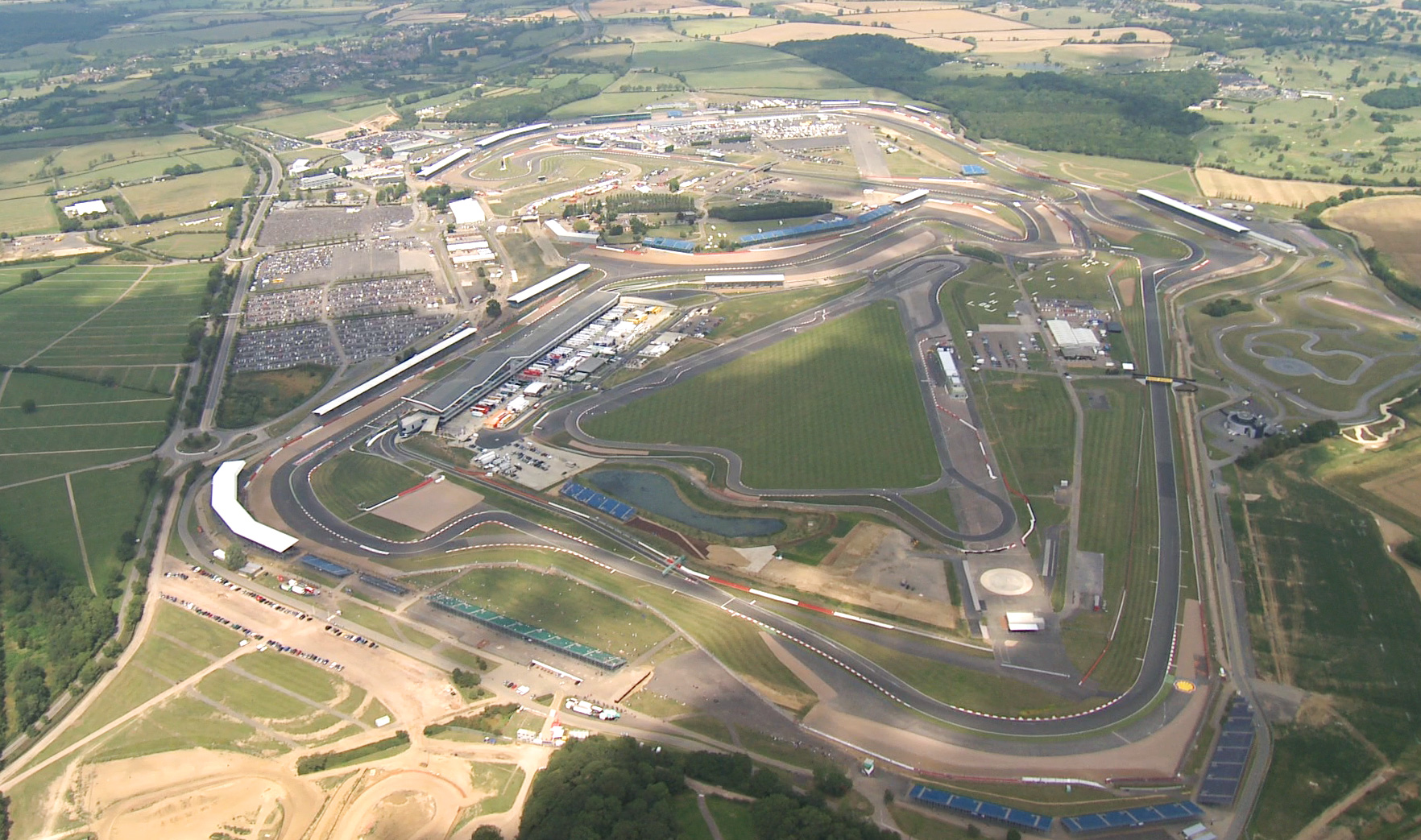
Aerial image of Silverstone circuit.
Lewis Hamilton has said: "it is the home of motorsport. The history and the turn-out we have is incredible. I have grown up watching Nigel Mansell win here and Damon [Hill] and Johnny [Herbert]. There is no other race that has the atmosphere this race has, because of the fans. You want to be the one who delivers for them - look out and see the British flags and there is no better feeling. The championship is the most important thing but a very close second is your home Grand Prix".
Lewis reckons that the Formula 1 drivers are not prepared for just how fast Silverstone’s corners will be in this year’s new cars. Formula 1 upped the pace this season, introducing wider, faster cars that have already led to new lap records. With more of the same expected at Silverstone, one of F1’s fastest circuits, Hamilton feels the drivers could be in for a lot of fun. “I think Copse is going to be flat this year. It is going to be rapid,” said the Mercedes driver. “None of us are prepared for just how quick Silverstone is going to be compared to previous years. It was awesome in the last race and Maggotts / Becketts is going to be the same. It will be a physical race for us being as it is mostly medium and high speed corners. The G we are pulling it will be at least one up maybe two, who knows, it will be a lot of fun”.
This is a sentiment echoed by Red Bull’s Daniel Ricciardo: “it’s going to be fun. I love high-speed corners. From Turn 9 to Turn 15, from Copse to Stowe, some of the coolest sequence of mild race track we go on all year,” he said. “We got a taste for it in Austria, the second, third sector we were carrying some speed. I think it’s a sign of what this weekend is going to be like I think.”
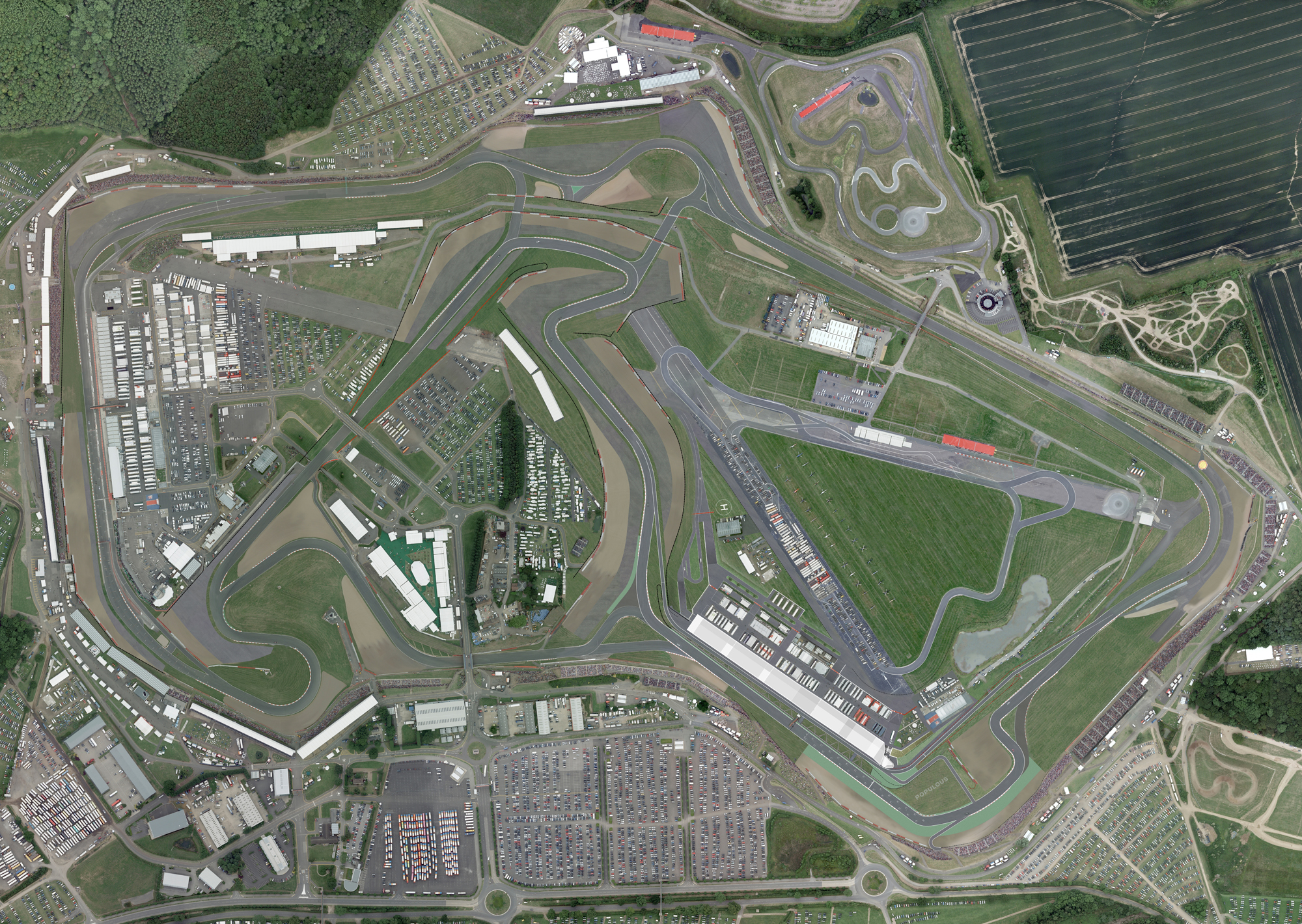
Aerial image of Silverstone circuit.
The changes being made to Silverstone will make it quicker than the old version (and how often do we say that about an F1 circuit?). Silverstone originally estimated F1 cars will lap the revised 5.9 km circuit at around 1’23.13 – suggesting an average lap speed of more than 255 kph. When you consider that the cars will probably be flat-out from the re-profiled (but no slower) Club, through Abbey up to Village, and then flat-out from The Loop and down the new Wellington Straight, it’s clear the new stretch of tarmac will be quite a bit quicker than the one it replaces, even with its two slow corners. The re-profiling will cut out the slow Abbey chicane and Brooklands will be wider and faster.
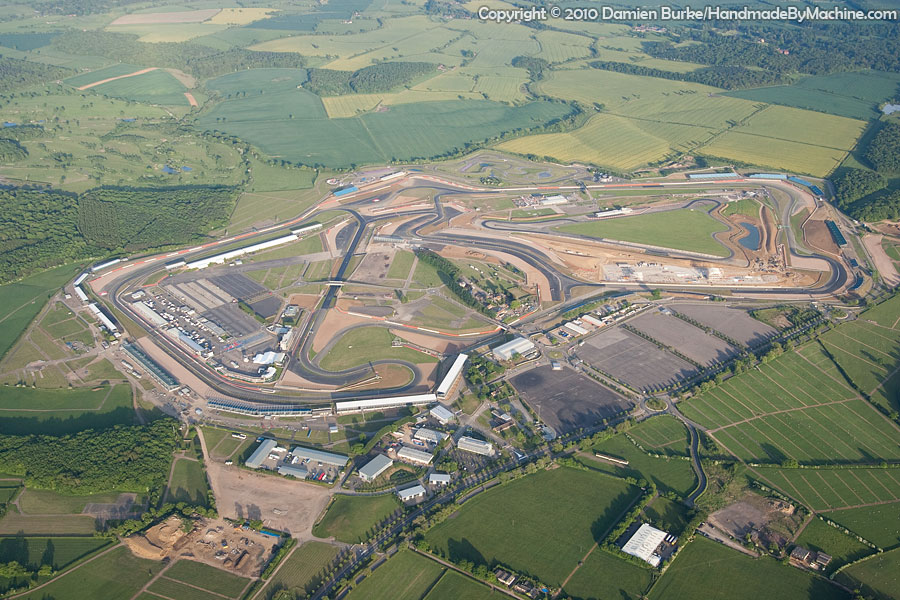
Aerial image of Silverstone circuit in 2010.
To some, the old second world war bomber base has outlived its era, ruined not so much by outdated facilities as by cack-handed attempts at modernisation. A glass pyramid might not have spoiled the Louvre courtyard, but the addition of the monstrous pits and hospitality complex called The Wing six years ago symbolises Silverstone’s failure to integrate past, present and future. Otherwise known as the “home of British motorsport”, the historic circuit of Silverstone was part of the original World Championship in 1950 and hosted the British Formula 1 Grand Prix for the 52nd time last year. Built on the site of a World War II airfield, Silverstone first hosted the British Grand Prix in 1948, a race which attracted a reported 100.000 spectators. The track is one of only four Grands Prix from the first year of the World Championship to remain a part of today’s F1 calendar (the others being Monaco, Spa and Monza). The layout of Silverstone has undergone significant changes over the years, mostly in a bid to reduce speed and increase safety. The most recent changes involved a substantial investment by the circuit’s owners, the British Racing Drivers’ Club (BRDC). In 2010, the BRDC signed a new 17-year deal which should guarantee Silverstone’s place on the Formula 1 calendar until at least 2027. A condition of the new deal was the redevelopment of the circuit, which was completed in 2011 and includes an entirely new “Wing” pits complex. The only cloud over the future of the British Grand Prix involves money. The current contract includes an ‘escalator clause’ that increases the hosting fee payable to the Formula 1 group each year, and the circuit struggles to make a profit despite charging some of the highest ticket prices on the current calendar. Nevertheless, Silverstone is one of the best attended Grands Prix on the current Formula 1 calendar. Race-day attendances have risen to almost 140.000 fans in recent years, with around 300.000 attending over the whole weekend.
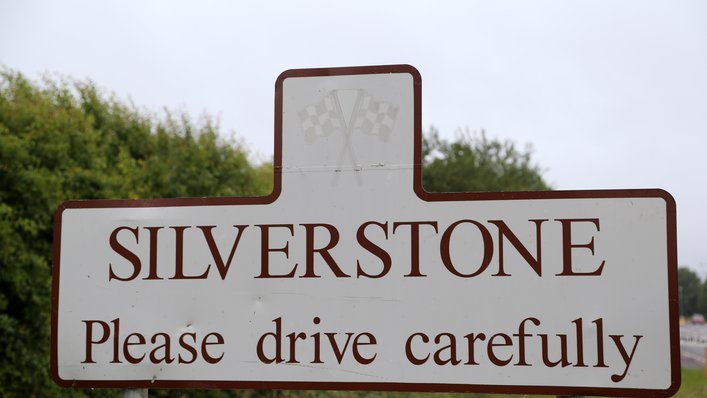
Silverstone circuit.
At 5.891 km, Silverstone is the third longest F1 circuit on the current calendar. Only Spa Francorchamps in Belgium (7.004 km) and the new Baku City Circuit (6.003 km) are longer. Together with Italy, Britain is the only country to have held a Grand Prix in every year of the World Championship since 1950. Silverstone Circuit is next to the Northamptonshire villages of Silverstone and Whittlebury. The circuit straddles the Northamptonshire and Buckinghamshire border, with the current main circuit entry on the Buckinghamshire side. The Northamptonshire towns of Towcester (5 miles) and Brackley (7 miles) and Buckinghamshire town of Buckingham (6 miles) are close by, and the nearest large towns are Northampton and Milton Keynes. Silverstone is the current home of the British Grand Prix. The 1950 British Grand Prix at Silverstone was the first race in the newly created World Championship of Drivers. The race rotated between Silverstone, Aintree and Brands Hatch from 1955 to 1986, but relocated permanently to Silverstone in 1987.
Silverstone speed hike stuns drivers. With his lap of 1’28.496 in 2017 Friday’s afternoon session, Valtteri Bottas lapped over 3.1 seconds faster than anyone had in Friday at last year’s British Grand Prix. This indicates F1 is on course for one of the biggest year-on-year lap time gains we’ve seen so far. Only in China did the cars find more speed compared with 12 months ago (3.7 seconds). Of course most of the time is being found in Silverstone’s dauntingly fast corners. The cars are generating some stunning forces: In excess of 6 G through Becketts. Even by Formula One’s extreme standards, this is eye-opening stuff for the drivers: “of all the tracks we have raced this season, Bottas said, this is probably the one on which I have experienced the biggest difference compared to last year. All the reference points you have built up in the past change and this can put you at a disadvantage: it took me a bit of time to get used to the amounts of grip we have, but I am feeling comfortable now.”

Clay Regazzoni having a Champion time in the pit lane at the 1979 British Grand Prix in Silverstone.
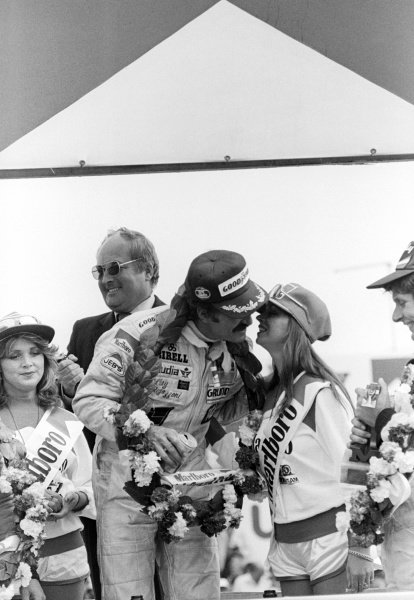
Clay Regazzoni having a Champion time in the pit lane at the 1979 British Grand Prix in Silverstone.
Located on a plateau, Silverstone never was a place of outstanding natural beauty. But its idiosyncrasies – particularly the weather, which regularly provides visitors with the challenging experience of all four seasons in a single afternoon, from heatwave to blizzard – were affectionately tolerated. And the circuit certainly has history on its side. Of the 33 drivers who have held the drivers’ title, 19 have won the British Grand Prix at Silverstone, starting with Nino Farina, the first champion, in 1950. A year later, the Scuderia Ferrari registered the first grand prix win in its history when José Froilán González beat the hitherto all-conquering Alfa Romeos, leading Enzo Ferrari, who ran the Alfa team before the war, to murmur something about having murdered his mother. At the end of the first lap in 1973 the young and headstrong Jody Scheckter triggered an unforgettably lurid nine-car accident in front of the grandstands. The memory of Nigel Mansell selling a dummy to Nelson Piquet, his Williams team-mate, on Hangar Straight is one that the passing of 30 years has not dimmed. But the great symbol of Silverstone’s latter-day failure is the misshapen Wing, built six years ago by the BRDC at the sole insistence of Bernie Ecclestone, who made it a condition of granting them a new deal. Ecclestone detested the BRDC, whom he regarded as blazered amateurs not attuned to the imperatives of global capitalism, and was happy to use any opportunity to diminish them. Satisfying his demands for more modern facilities cost the club £27m it did not have and had to borrow. Far worse than the financial burden, however, was the damaging effect the new building had on the circuit as a whole. The Wing was installed at what was once the back end of the circuit, between Club and Abbey corners, meaning that Formula One abandoned the traditional pits and paddock, between Woodcote and Copse. Formula One, however, could hardly follow suit, having been the reason for the folly’s existence in the first place. And it could be said that the characterless concrete desert of the new paddock suits the current F1 down to the ground. Those with any feeling for the sport detest it, looking back with fondness on the old paddock cafe, where track marshals were served an all-day full English. A link to cultural history. Silverstone trusts big Wing has all the angles covered. A Grand Prix at Silverstone without Copse Corner as its first corner and Woodcote as its last is probably a race not worth having. Once upon a time, the sight of Michael Schumacher taking his Ferrari through Copse flat in seventh gear was almost enough to banish a sense of disillusionment with the entire sport, and even that spectacle relied for its full effect on the brain’s ability to overlay something seen in real time with images of earlier occasions in the same location, from Alberto Ascari to Ayrton Senna. Instead, Silverstone’s grand prix circuit is now full of meaningless passion-killing twiddly bits, a process that began with the introduction of the Woodcote chicane in 1975 and includes the daft Arena complex. All you can say in the circuit’s favour is that most of the corners retain names whose origins lie in actual geographical or historical features. But in terms of an annual Formula One race, when you treat such a legacy as something not worth preserving properly, you deserve everything you get. The 130.000 fans who will pack the place out on Sunday, and whose enthusiasm has miraculously survived no end of passive abuse, are the ones who have always deserved better. As much as a London road race seems attractive, no one really believes it will garner the same kind of passion and excitement that Silverstone does. The historic nature of the track, coupled with the camping and holiday feel it creates makes it unique in many other circuits.
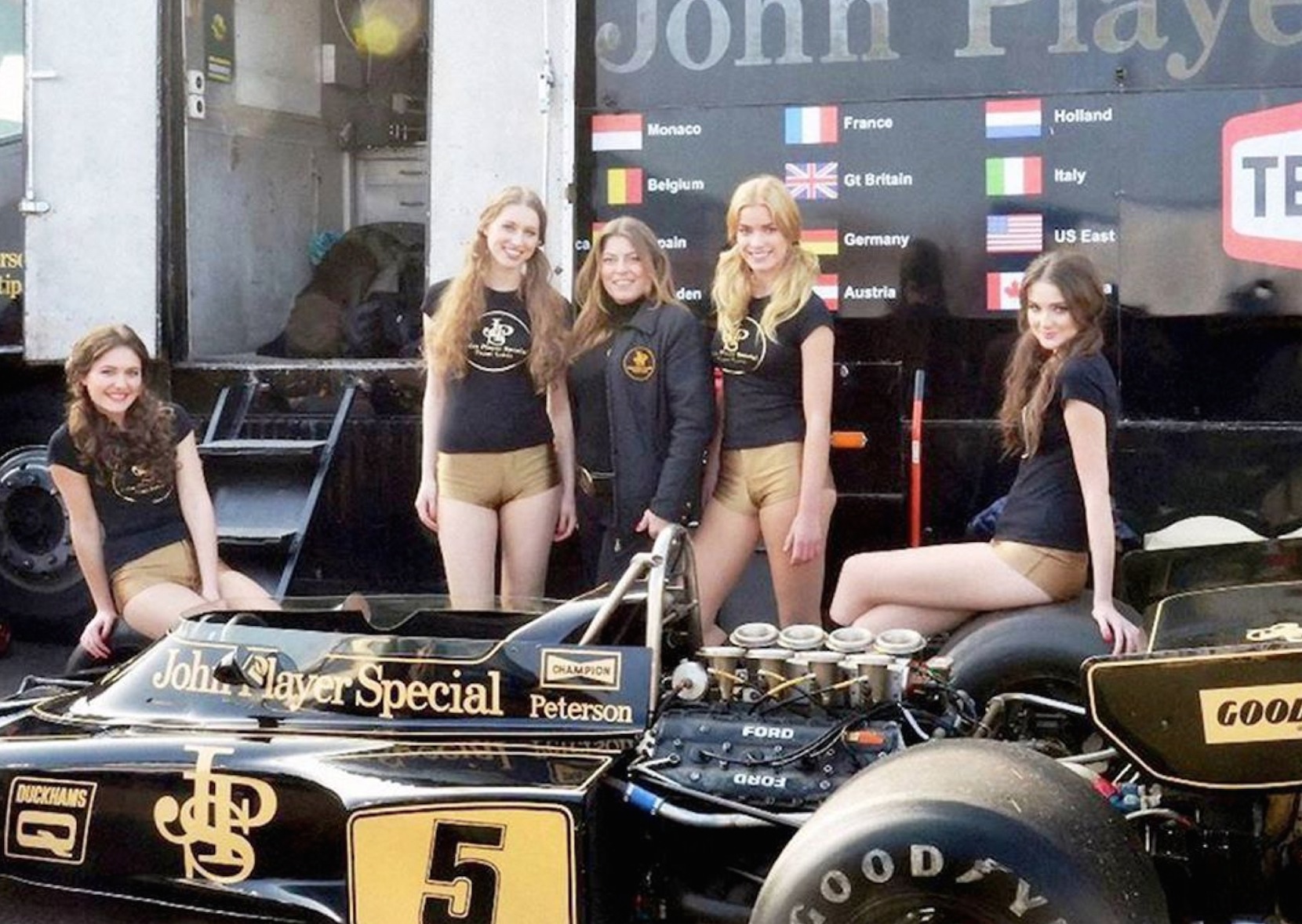
The pits at the 1975 British Grand Prix. Ronnie Peterson is nowhere in sight but that JPS Lotus 72E doesn’t look lonely.
Like so many of England's racing circuits, Silverstone started life as an aerodrome. When the Second World War ended in 1945, England's other two circuits, Donington Park and the legendary Brooklands, had fallen into disrepair. And so it was that the outer taxiways and interconnecting runways of Silverstone became adopted by the Royal Automobile Club as the home for the British Grand Prix in 1948. The circuit was fast and challenging and in 1949 the shape was formed that remains the basis of the track to this day. When the Formula One World Championship was incepted in 1950, Silverstone held the very first round, won by Giuseppe Farina in an Alfa Romeo. In 1951 the British Racing Drivers' Club (BRDC) was handed the lease by the RAC, and huge modifications were made. The pits were moved to the straight between Woodcote and Copse, from the Farm straight where they had originally been, and a short circuit was built within the larger circuit, cutting from Becketts corner to Woodcote. From 1955 the British Grand Prix swapped venues between Aintree and Silverstone, but with the advent of the 1960s, Aintree fell out of favour and the race was switched between Silverstone and Brands Hatch. In 1971 the British Racing Drivers' Club (BRDC) bought the entire 720 acre plot on which Silverstone sits and went about redeveloping the track. New pits were built and a chicane was erected at Woodcote which provided close finishes and great overtaking opportunities. In 1987, with speeds reaching astounding levels, a corner was built before Woodcote, and in 1992 a new complex of corners was created between Farm and Woodcote. And in recent years various upgrades have been made to the track's facilities. A racing school now exists at the circuit and with government funding a new bypass has been built, greatly improving access to the once notoriously out-of-the-way venue. In 2010 came another major change to the circuit's Formula One layout, designed to further improve the venue for spectators and provide an even greater driver challenge. The new infield layout juts right at the reworked Abbey bend before heading into the new Arena complex of turns. This takes drivers on to the main straight of Silverstone’s National circuit, before rejoining the previous Grand Prix layout at Brooklands.
|
Silverstone Circuit 'Home of British Motor Racing' |
|
|
Capacity |
150.000 |
|
|
|
|
Arena Grand Prix Circuit (2011 – present) |
|
|
Length |
5.891 km (3.661 mi) |
|
Turns |
18 |
|
Lap record |
1:30.621 (Lewis Hamilton, Mercedes, 2017, F1) |
|
Arena Grand Prix Circuit (2010) |
|
|
Length |
5.901 km (3.667 mi) |
|
Turns |
18 |
|
Lap record |
1:30.874 (Fernando Alonso, Ferrari, 2010, F1) |
|
Bridge Grand Prix Circuit |
|
|
Length |
5.141 km (3.194 mi) |
|
Turns |
17 |
|
Lap record |
1:18.739 (Michael Schumacher, Ferrari, 2004, F1) |
|
International Circuit |
|
|
Length |
3.619 km (2,249 mi) |
|
Turns |
10 |
|
National Circuit |
|
|
Length |
2.638 km (1,639 mi) |
|
Turns |
6 |
|
Stowe Circuit |
|
|
Length |
1.281 km (0,796 mi) |
|
Turns |
5 |
Silverstone is built on the site of a World War II Royal Air Force bomber station, RAF Silverstone, which opened in 1943. The airfield's three runways, in classic WWII triangle format, lie within the outline of the present track. Silverstone was first used for motorsport by an ad hoc group of friends who set up an impromptu race in September 1947. One of their members, Maurice Geoghegan, lived in nearby Silverstone village and was aware that the airfield was deserted. He and eleven other drivers raced over a two-mile circuit, during the course of which Geoghegan himself ran over a sheep that had wandered onto the airfield. The sheep was killed and the car written off, and in the aftermath of this event the informal race became known as the Mutton Grand Prix.
The next year the Royal Automobile Club took a lease on the airfield and set out a more formal racing circuit. Their first two races were held on the runways themselves, with long straights separated by tight hairpin corners, the track demarcated by hay bales. However, for the 1949 International Trophy meeting, it was decided to switch to the perimeter track. This arrangement was used for the 1950 and 1951 Grands Prix. In 1952 the start line was moved from the Farm Straight to the straight linking Woodcote and Copse corners, and this layout remained largely unaltered for the following 38 years. For the 1975 meeting a chicane was introduced to try to tame speeds through the mighty Woodcote Corner, and Bridge Corner was subtly rerouted in 1987. The track underwent a major redesign between the 1990 and 1991 races, transforming the ultra-fast track (where in its last years every corner was taken in no lower than fourth or fifth gear, depending on the transmission of the car, except for the Bridge chicane, which was usually taken in second gear) into a more technical track. The reshaped track's first F1 race was perhaps the most memorable of recent years, with Nigel Mansell coming home first in front of his home crowd. On his victory lap back to the pits Mansell even found time to pick up stranded rival Ayrton Senna and give him a lift on his side-pod after Senna's McLaren had run out of fuel on the final lap of the race.
Following the deaths of Senna and fellow Grand Prix driver Roland Ratzenberger at Imola in 1994, many Grand Prix circuits were modified in order to reduce speed and increase driver safety. As a consequence of this the entry from Hangar Straight into Stowe Corner was modified in 1995 so as to make its entry less dangerous. In addition, the flat-out Abbey kink was modified to a chicane in just 19 days before the 1994 GP. Parts of the circuit, such as the starting grid, are 17 metres wide, complying with the latest safety guidelines.
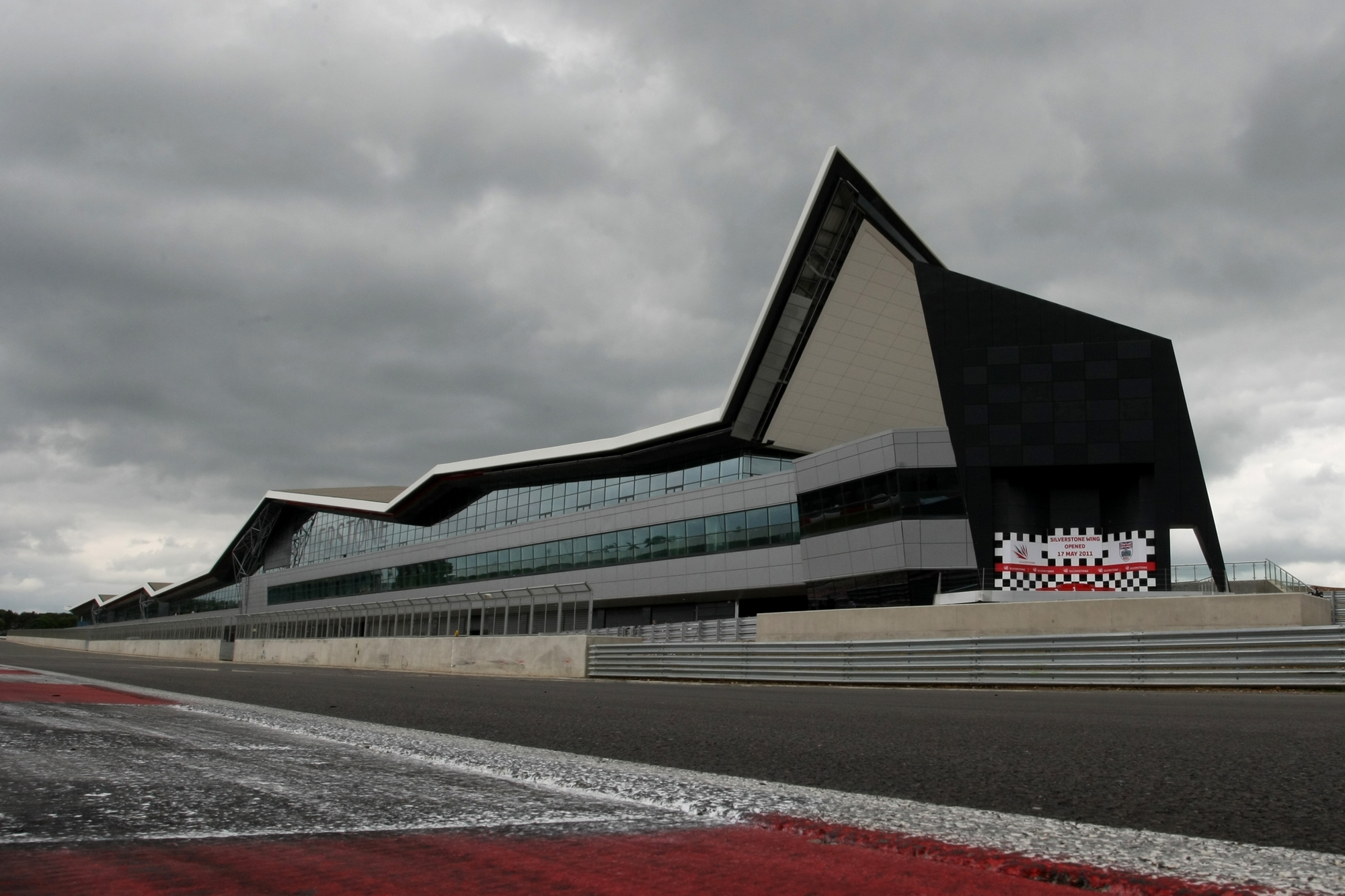
The Silverstone Wing.
After a new pit building, the Silverstone Wing, was completed in time for the 2011 race, the start of the track was relocated to between Club Corner and Abbey Corner. Almost flat out, the right-hander of Abbey leads immediately into the left-hander of Farm before cars brake heavily into the second gear, right-handed turn three; Village Corner. The even slower left-hander of the Loop comes immediately after and leads into the flat-out left-hander of Aintree, before cars head down the DRS zone of the Wellington Straight; designed in 2010 to promote overtaking at the track. Turn 6, the left hander of Brooklands, is taken by drivers in second gear and leads immediately into Luffield, another second gear curve; a right-hand hairpin. The right-handed kink of Woodcote leads cars down the old pit straight, before the difficult sixth-gear right-hander of Copse, with a minimum speed of 175 mph in the dry for Formula One cars. Then, the challenging complex of Maggotts, Becketts and Chapel - a left-right-left-right-left complex with a minimum speed of 130 mph - lead cars down the 770-metre Hangar Straight with the fifth-gear right-hander of Stowe at the end. The fifteenth turn of the track, Stowe, has a minimum speed of 125 mph and precedes a short straight, named Vale, which leads cars downhill towards the Club complex. Heavy braking is required for the left-hander of turn 16, and understeer can be an issue for the next right-handers of turns 17 and 18, as cars tentatively accelerate round to the start-finish straight. The fastest ever lap of the current circuit configuration was 1:26.600 recorded in qualifying for the 2017 British Grand Prix by Lewis Hamilton, while the official race lap record is 1:30.621 also set by Lewis Hamilton at the same event.
With the termination of hostilities in Europe in 1945, the first motorsport event in the British Isles was held at Gransden Lodge in 1946 and the next on the Isle of Man, but there was nowhere permanent on the mainland which was suitable. In 1948, Royal Automobile Club (RAC), under the chairmanship of Wilfred Andrews, set its mind upon running a Grand Prix and started to cast around public roads on the mainland. There was no possibility of closing the public highway as could happen on the Isle of Man, or the Channel Islands; it was a time of austerity and there was no question of building a new circuit from scratch so some viable alternative has to be found. A considerable number of ex-RAF airfields existed, and it was to these the RAC turned their attention to with particular interest being paid to two near the centre of England – Snitterfield near Stratford-upon-Avon and one behind the village of Silverstone. The latter was still under the control of the Air Ministry, but a lease was arranged in August 1948 and plans put into place to run the first British Grand Prix since the RAC last ran one at Brooklands in 1927 (those held at Donington Park in the late 1930s had the title of ‘Donington Grand Prix’).

A grid girl on a windy day on 06 July 2008. Photo by Rui Vieira.
Despite possible concerns about the weather, the 1948 British Grand Prix began at Silverstone on Thursday 30 September 1948. The race took place on 2 October. The new circuit was marked out with oil drums and straw bales and consisted of the perimeter road and the runaways running into the centre of the airfield from two directions. Spectators were contained behind rope barriers and the officials were housed in tents. An estimated 100.000 spectators watched the race. The race was 239 miles long and was run at an average speed of 72.28 mph. The second Grand Prix at Silverstone was scheduled for May 1949 and was officially designated the British Grand Prix. It was to use the full perimeter track with a chicane inserted at Club Corner. The length of the second circuit was exactly three miles and the race run over 100 laps, making it the longest post-war Grand Prix held in England. The race average speed had risen to 77.31mph. The attendance was estimated at anything up to 120.000. The 1950 British Grand Prix was a significant occasion for two reasons: it was the first ever World Championship Grand Prix, carrying the title of the European Grand Prix; and the event was graced by the presence of King George VI and Queen Elizabeth – the first and only time a reigning monarch has attended a motor race in Britain. The year was the institution of the World Championship for Driver, the race average having increased to 90.96 mph; however the race distance had been reduced to 205 miles. In 1951 the race distance had increased to 263 miles, and the race average speed was now 96.11 mph. 1951 also saw the British Racing Drivers' Club (BRDC) take over the lease from the RAC, and set about making the circuit into something more permanent. In 1952, the RAC decided it no longer wished to run the circuit, and on 1 January the lease was taken on by the BRDC. The lease covered only the perimeter track and other areas at specific times. The original pits between Abbey and Woodcote were demolished, and new pit facilities were constructed between Woodcote and Copse. The 1954 Grand Prix season was the new 2.5-litre Formula One and had attracted interest from some major players. Lancia had joined the fray with their D50, and Daimler-Benz were back; the appearance of Lancia meant that there were three Italian teams completing at the highest level, the others being Ferrari and Maserati. From 1955, the Grand Prix was alternated between Aintree and Silverstone, until 1964 when Brands Hatch took over as the alternative venue. By the time the Grand Prix returned to Silverstone in 1956, Mercedes-Benz had gone, as had Lancia as an independent entrant, the cars having been handed to Scuderia Ferrari, who ran them as ‘Lancia-Ferraris’. For 1958 drastic rule changes were introduced into Formula One, Fangio had retired and Maserati had withdrawn due to financial difficulties. Throughout the season the battle was between Ferrari and Vanwall. At the British Grand Prix of 1960, the front-engined cars were completely outclassed, the podium going to the Coventry-Climax-powered cars, with victory going to Jack Brabham in the works Cooper T53 from John Surtees and Innes Ireland in their Lotus 18s. 1961 was the year of the new 1.5 litre Formula One introduced by the governing body on safety grounds. In 1962, the second year of the Formula, the International Trophy was run for the 1.5 litre cars. Clark was to win the British Grand Prix when it returned to Silverstone in 1963, driving the Lotus-Climax 25. By now, even Ferrari had succumbed to the rear-engined layout. 1973 was the year that Jody Scheckter lost control of his McLaren at the completion of the first lap, spinning into the pit wall and setting in motion the biggest accident ever seen on a British motor racing circuit. The race was stopped on lap two and the carnage cleared away; it speaks highly for the construction of the cars that only one driver was injured. The race was won Scheckter’s teammate, Peter Revson (McLaren M23-Cosworth) from Peterson (Lotus 72E) and Denny Hulme (McLaren M23). The race average speed had risen again to 131.75mph. The 1973 débâcle wrought changes upon Silverstone as it was deemed necessary to slow these cars through Woodcote, therefore a chicane was inserted. In the 1983 British Grand Prix, the first Cosworth-powered car was in 13th place on the grid, all the cars ahead of it were being powered by turbocharged engines. Fuel consumption of the turbos was heavy and refuelling mid-race had become de rigueur, the mechanics now playing as important part as the drivers.
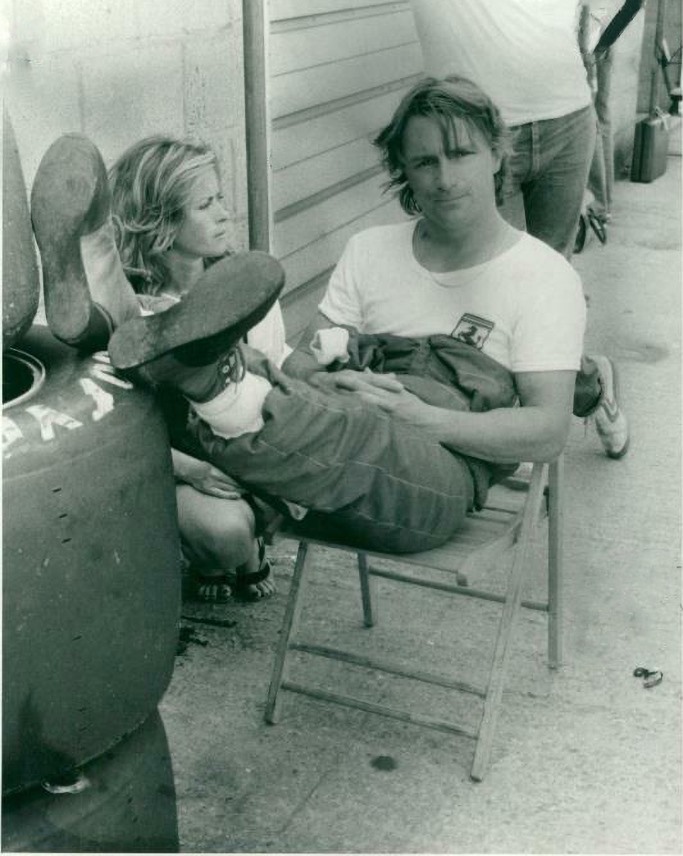
Rene' Arnoux in relax with Pascale before the pole position at Silverstone in 1983.
With the ever-increasing power, speeds were continually on the up and in practice René Arnoux became the first person to lap the circuit in under 1:10.000 with a time of 1:09.462 in his Ferrari 126 C3, a lap at over 150 mph. In the race, the lap record was raised to over 140 mph by Frenchman Alain Prost who won the race in the Renault RE40 at an average speed of 139.218 mph, from Nelson Piquet in the Brabham-BMW BT52B and Patrick Tambay in a Ferrari. Finishing fourth, also using Renault power, was the Lotus 94T of future British hero, Nigel Mansell. The 1985 British Grand Prix saw Keke Rosberg in his 1,150 bhp (858 kW; 1,166 PS) Williams FW10-Honda set a qualifying lap at over 160 mph. Three others clocked an average lap speed of over 159 mph. Making Rosberg's lap even more remarkable was that he had a deflating rear tyre and the track was still slightly damp from the rain that hit the circuit during the day. The turbo era had reached its zenith. This was a peak in the history of Silverstone and while Prost put the new lap record up to 150.035 mph, like most races of the era it was something of an economy run as the FIA had limited fuel capacities (220 litres per car per race). Prost went on the win in the race, in the McLaren MP4/2B, at an average of 146.246 mph from the Ferrari 156/85 of Alboreto and the Ligier JS25 of Laffite. Someone had become rather more than a little concerned over the 160 mph lap in 1985, for by the time the Grand Prix returned in Silverstone in 1987, a new corner was inserted before Woodcote which changed the character of the circuit. And so to the 1987 British Grand Prix, the event now firmly established at Silverstone. The first two placings were a repeat of the 1986 race at Brands Hatch, Mansell winning from his Williams-Honda teammate Piquet at 146.208 mph and Ayrton Senna in the Lotus-Honda. The race will always be remembered the inter-team rivalry of the Williams pairing. Following a late pit stop in a bid to cure a vibration in the car, Mansell found himself 16.8 secs behind Piquet with only 17 laps to go. But Mansell proceeded to eat into Piquet’s lead – more than a second per lap – until with five laps to go the gap was only 1.6 seconds. With two laps to go Mansell slipstreamed Piquet down the Hangar Straight, jinked left and then dived right to pass Piquet into Stowe. To a tumultuous reception, Mansell went on to win the race. 1990s. The British Grand Prix at Silverstone once again was over 190 miles and was won at 145.253 mph; After the Grand Prix, it had already been decided to extensively redesign track's layout. Nearly every part of Silverstone (except Copse, Abbey and all of the straights, save the Farm Straight) was redesigned. The ultra-high speed Club and Stowe corners were made slower and a chicane was placed before Stowe. Maggotts, Becketts and Chapel were re-designed as very fast snaky esses that proved to be even more challenging than the original series of corners- the considerable amount of lateral g from side to side became the highlighted challenge of the new circuit. A new twisty infield section called Luffield was created in place of the Farm straight and the Bridge chicane. Despite these alterations, the Grand Prix and World Sportscar circuses both very much approved of the new layout; Silverstone was still fast, which is what it has always been known for. From the start of 1998, the FIA decreed that all Formula One grids must be straight: in order to comply with this, the RAC moved the start line forward at Silverstone but not, significantly, the finish line. This led to some confusion at the end of the Grand Prix, which was scheduled for 60 laps, but was effectively 59.95 laps: it was more than a little fortunate that the timing was being taken from the finish line and not the start line as the winning car was in the pits at the end of the race and the Ferrari pit was situated between the two lines. The chequered flag is supposed to be waved at the winning car and then showed to the other competitors, but it was waved at the second man who thought that he had won! 2000s. For Silverstone’s first Grand Prix of the 21st Century, the FIA decreed that the race should be moved to April, and the event took place over Easter, with the GP itself run on Easter Sunday. In hindsight this was a poor decision by the FIA, who failed to take into account the unpredictable weather in Britain at this time of year. It rained almost continually for the best part of three weeks before the event and most of Good Friday; by Easter Saturday the car parks had virtually collapsed and were completely closed. Although most of the race day itself was fine, the damage was done and many thousands of spectators were unable to get to Silverstone to witness David Coulthard win his second straight victory in the event, from his McLaren teammate Mika Häkkinen, with Michael Schumacher third for Ferrari.
Following Hamilton’s victory in the 2007 Canadian Grand Prix, Silverstone reported that ticket sales had "gone through the roof"; circuit director Ian Phillips added, "we haven’t seen this level of interest since Mansell-mania in the late 80s and early 90s."
Records
Photo gallery
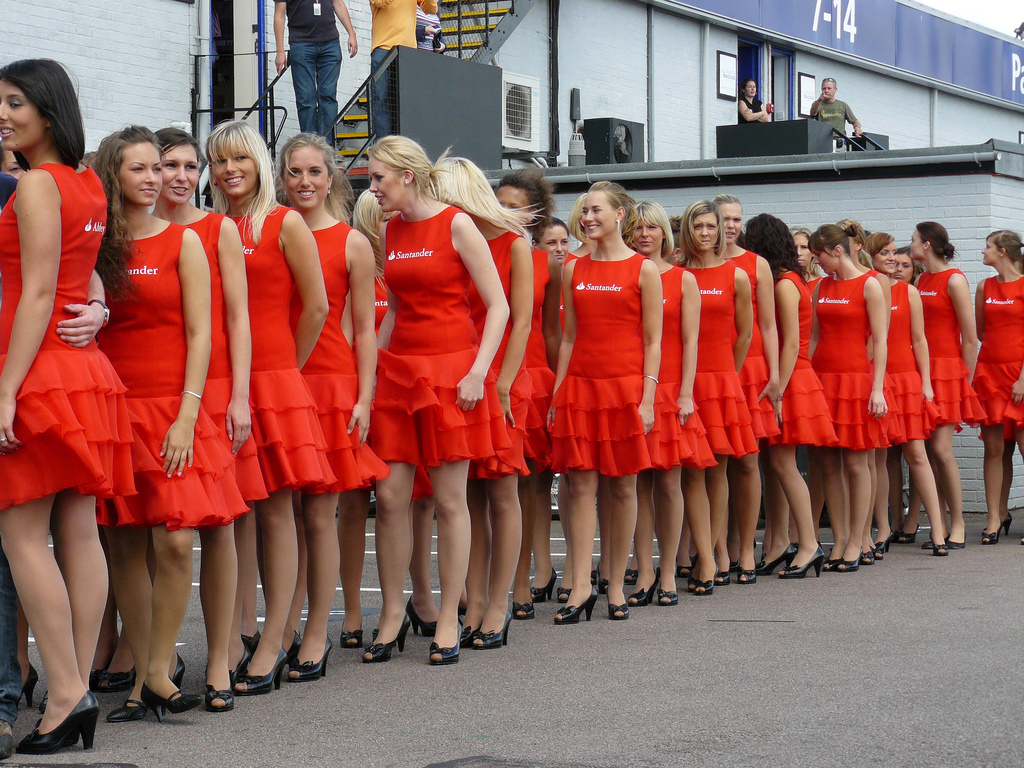
Grid girls on 05 July 2008. Photo by Paul Gibson.
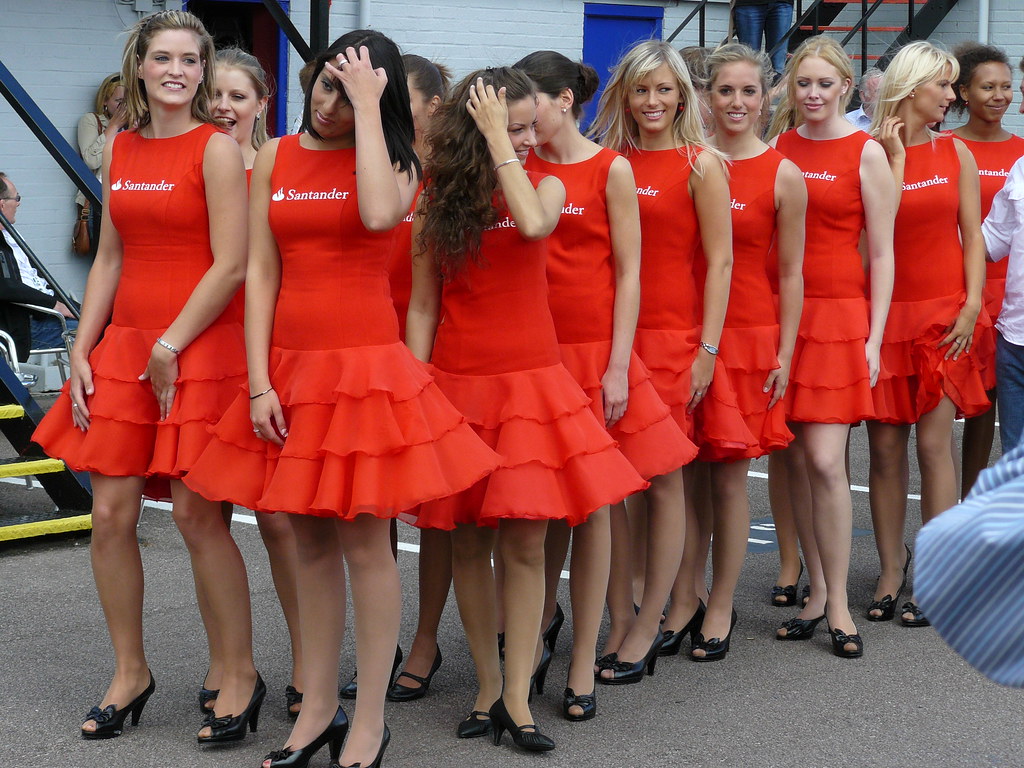
Grid girls on 05 July 2008. Photo by Paul Gibson.
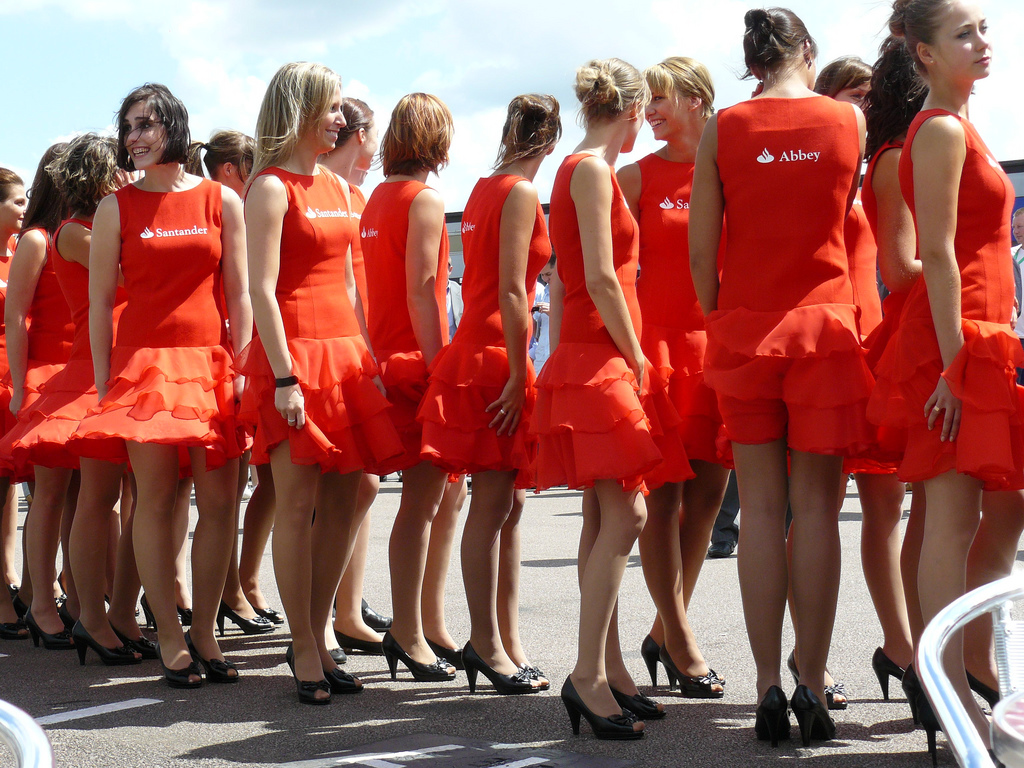
Santander grid girls at Silverstone on 05 July 2008. Photo by Paul Gibson.
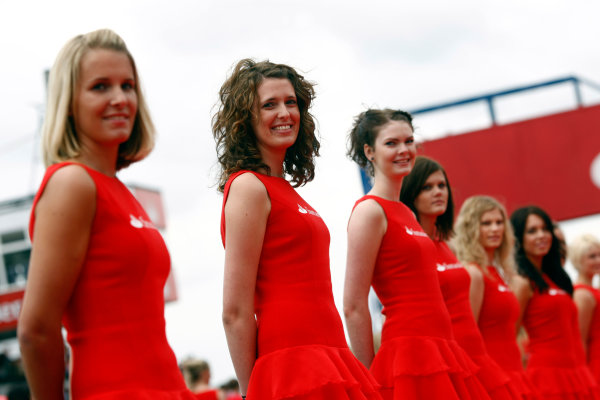
Grid girls at Silverstone on 21 June 2009. Photo By Lat Photographic.

Grid girls on the drivers parade at Silverstone, England, on Sunday 21 June 2009. Photo by Daniel Kalisz.
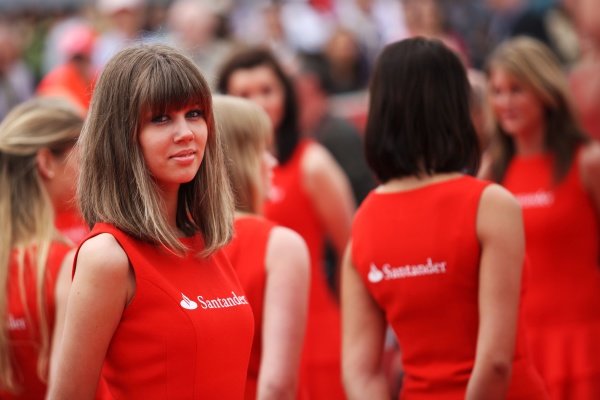
Grid girls on the drivers parade at Silverstone on Sunday 21 June 2009. Photo by Daniel Kalisz.
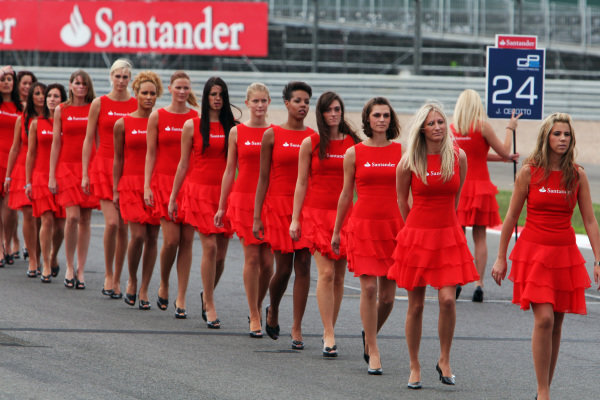
Grid girls at the British Grand Prix, qualifying day, in Silverstone on Saturday 10 July 2010.
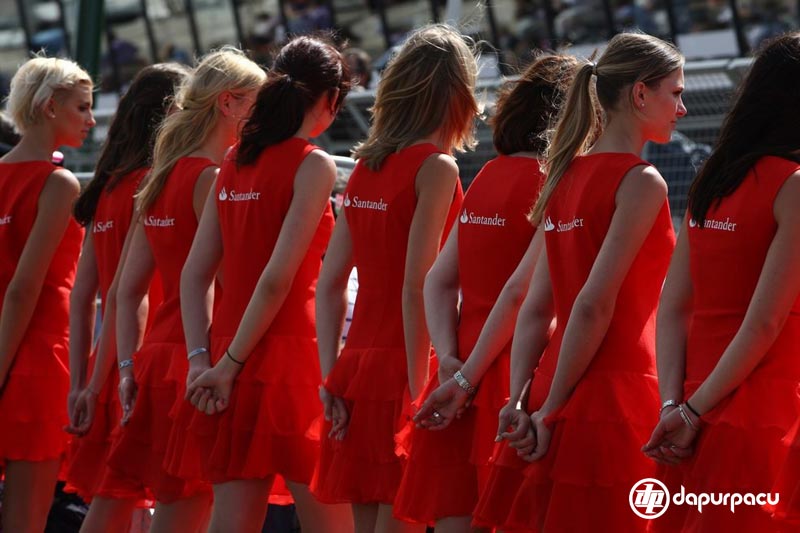
Grid girls at the British Grand Prix, qualifying day, in Silverstone on Saturday 10 July 2010.
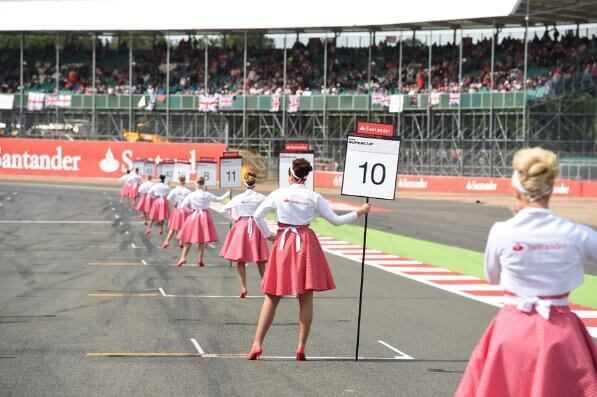
Grid girls at the 2014 British Grand Prix in Silverstone.
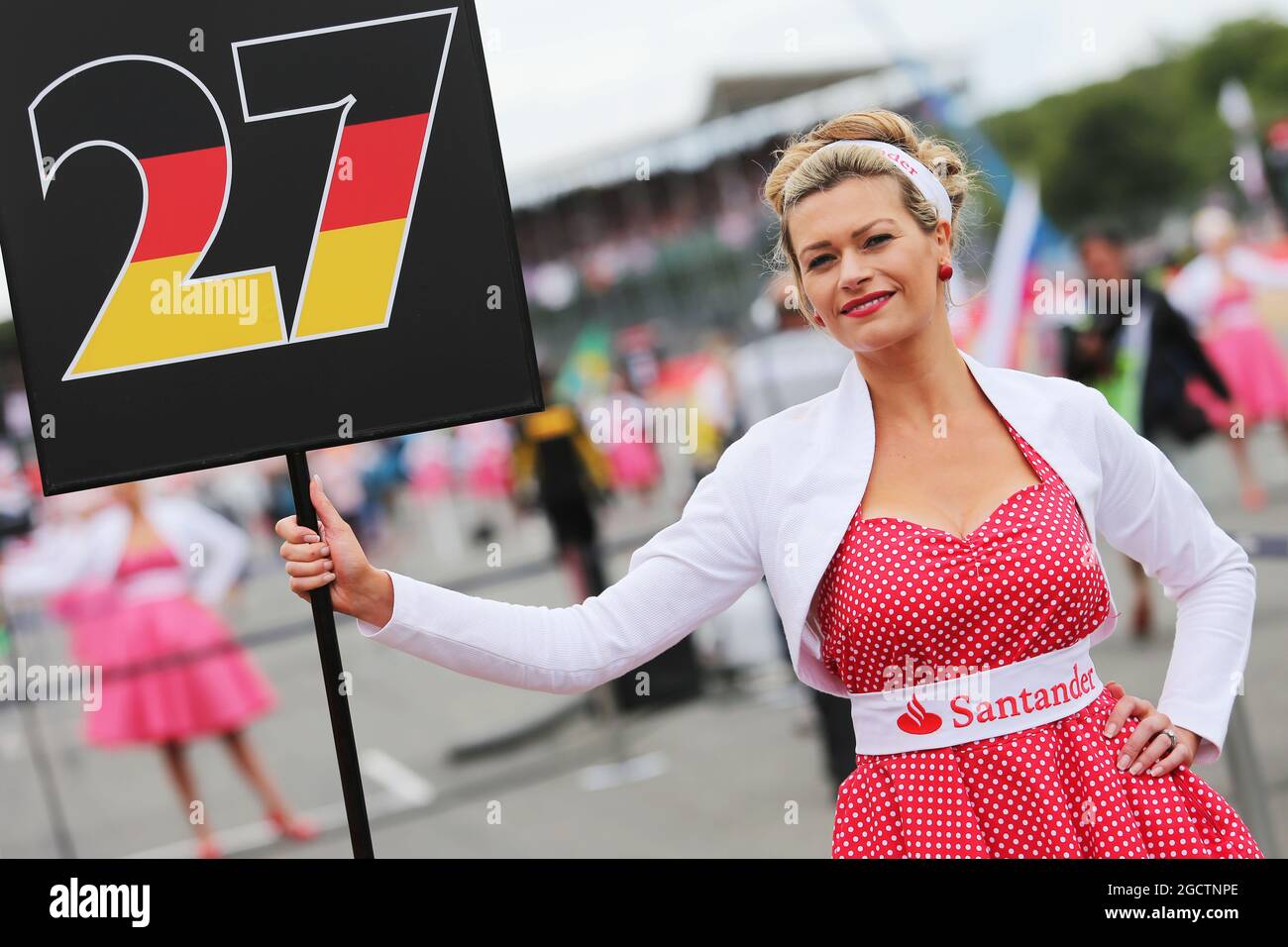
A grid girl at the British Grand Prix in Silverstone on Sunday 06 July 2014. Photo by James Moy.
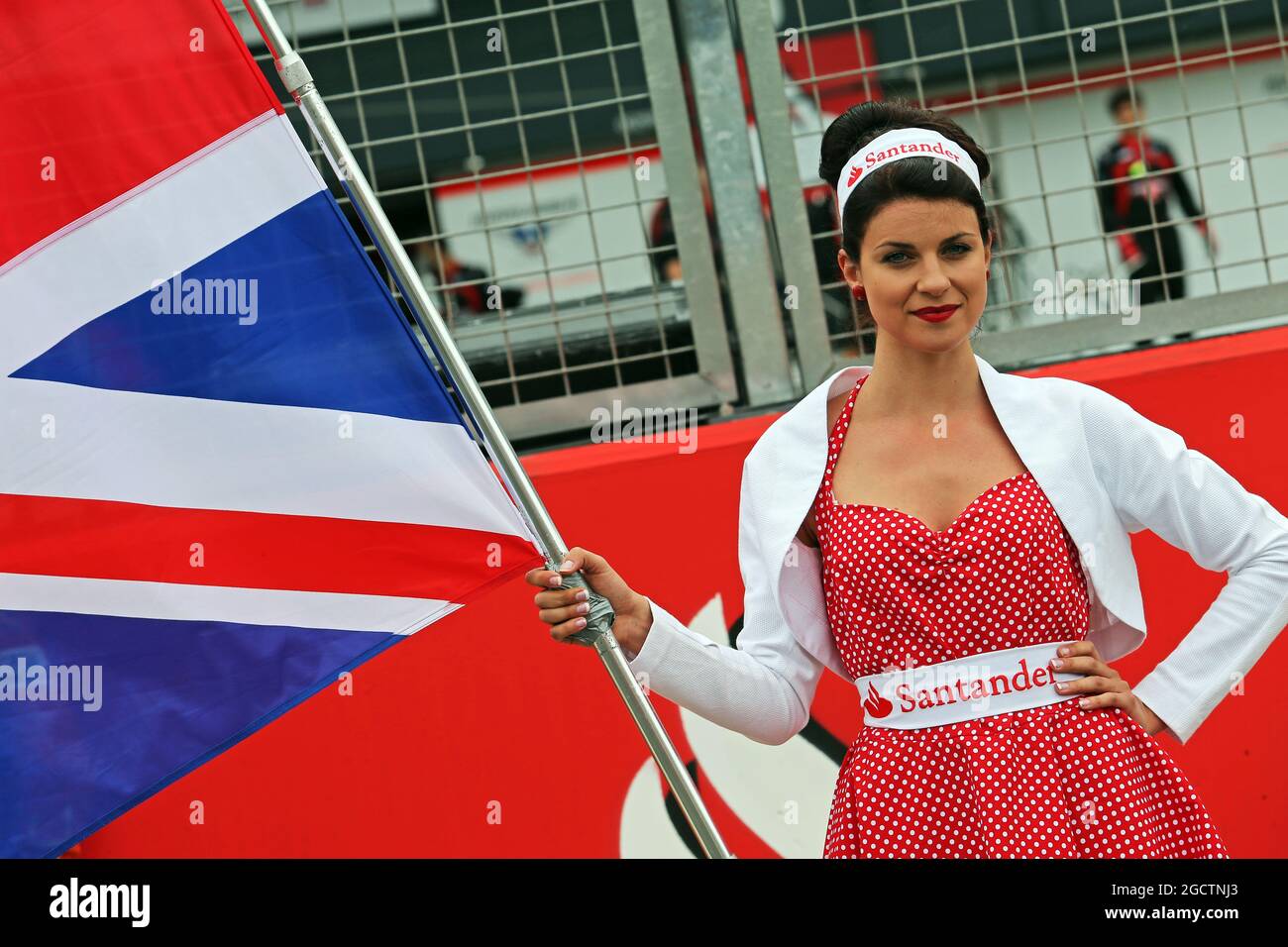
A grid girl at the British Grand Prix in Silverstone on Sunday 06 July 2014. Photo by James Moy.
Videos
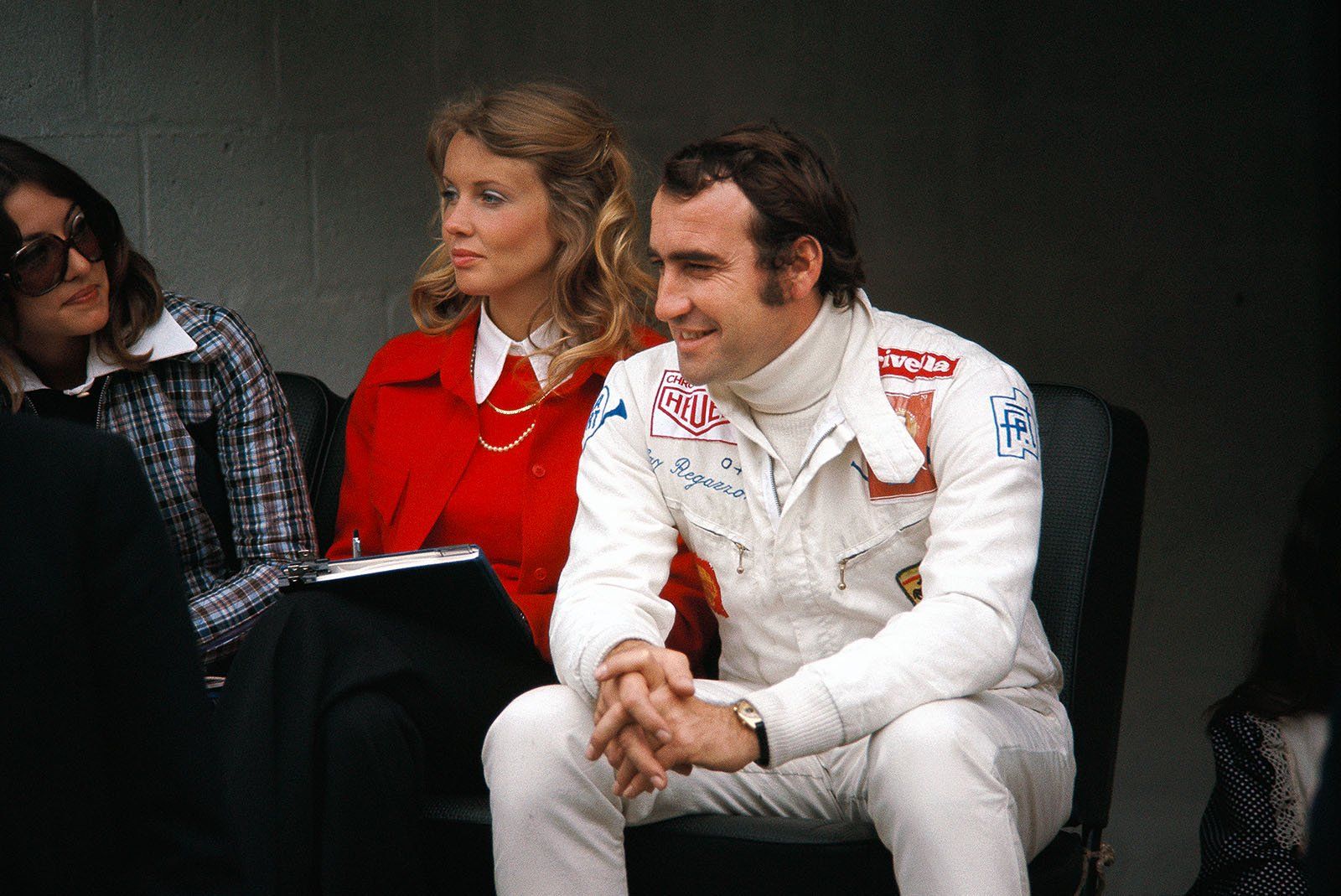

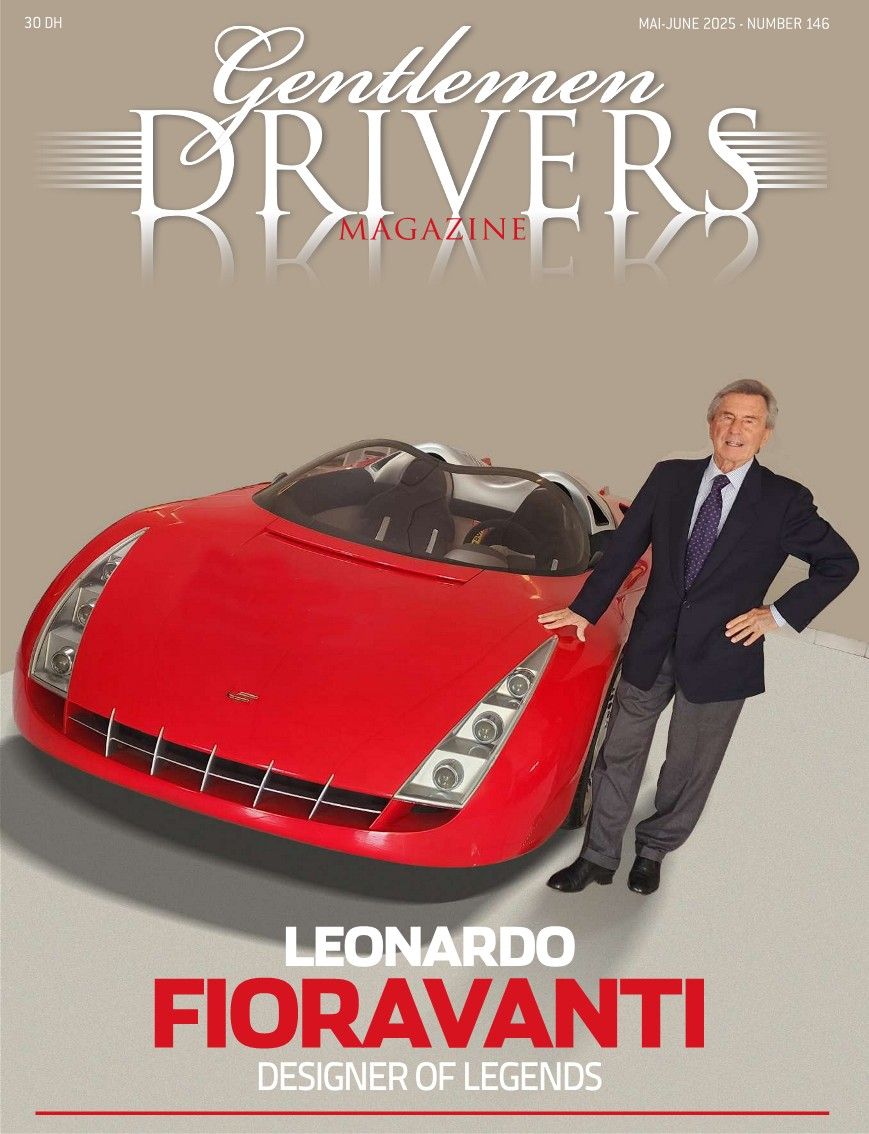
Comments
Authorize to comment